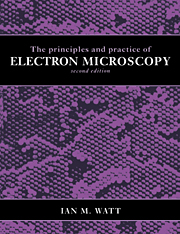Book contents
- Frontmatter
- Contents
- Preface to first edition
- Preface to second edition
- 1 Microscopy with light and electrons
- 2 Electron–specimen interactions: processes and detectors
- 3 The electron microscope family
- 4 Specimen preparation for electron microscopy
- 5 The interpretation and analysis of micrographs, pages 189 to 223
- The interpretation and analysis of micrographs, pages 224 to 262
- 6 Analysis in the electron microscope
- 7 Specialised EM- and other microscopical and analytical techniques
- 8 Examples of the use of electron microscopy
- Appendixes
- Bibliography
- Name index
- Subject index
6 - Analysis in the electron microscope
Published online by Cambridge University Press: 05 June 2012
- Frontmatter
- Contents
- Preface to first edition
- Preface to second edition
- 1 Microscopy with light and electrons
- 2 Electron–specimen interactions: processes and detectors
- 3 The electron microscope family
- 4 Specimen preparation for electron microscopy
- 5 The interpretation and analysis of micrographs, pages 189 to 223
- The interpretation and analysis of micrographs, pages 224 to 262
- 6 Analysis in the electron microscope
- 7 Specialised EM- and other microscopical and analytical techniques
- 8 Examples of the use of electron microscopy
- Appendixes
- Bibliography
- Name index
- Subject index
Summary
Although the moving force behind the development of electron microscopes was the potential of shorter wavelength illumination to reveal finer detail than the light microscope, the richness of interactions between specimen and the illumination makes the electron microscope capable of determining much more than morphological structure. In addition to the analysis of sizes and shapes already mentioned (Image Analysis, Chapter 5) it is possible to obtain information on the elemental composition of specimens, and in the TEM about any crystalline compounds which are present. All this on a micrometre scale at worst, and at best down to sub-nanometre dimensions. On some specimens surface and bulk compositions can be distinguished and the presence and distribution of impurities can be shown.
This chapter will describe the types of analysis possible in electron microscopes, using the techniques:
Electron diffraction
X-ray microanalysis
Electron energy loss spectroscopy
Auger electron spectroscopy
Cathodoluminescence
Electron diffraction
Electron diffraction in the TEM
In the TEM the strong interaction between crystalline specimens and the electron beam can be used to derive crystallographic information in a number of different ways. Not all are possible on all microscopes.
High-resolution diffraction
It is possible to use many commercial TEM columns as conventional diffraction cameras (Chapter 2, page 52–3), with camera length typically about 300–400 mm and very well-resolved patterns because the illuminating spot can be made very small.
- Type
- Chapter
- Information
- The Principles and Practice of Electron Microscopy , pp. 263 - 302Publisher: Cambridge University PressPrint publication year: 1997

